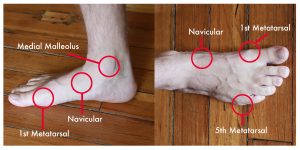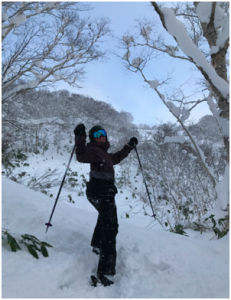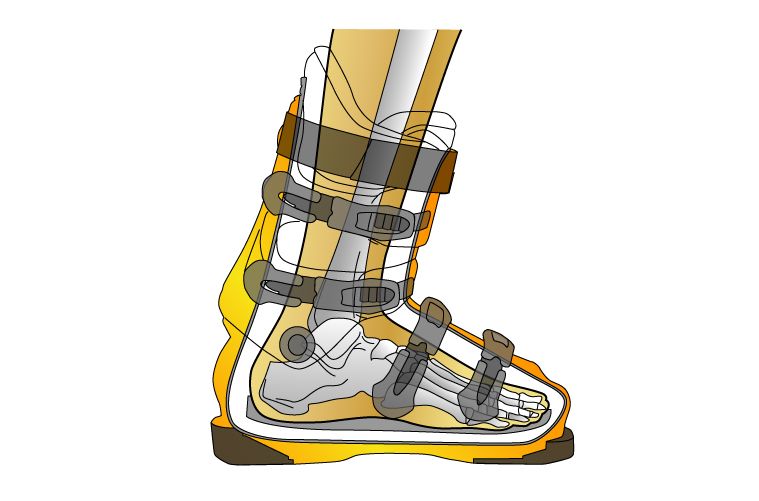Why do my feet hurt so much skiing? Have you considered a proper ski boot fitting?
I was lucky enough to spend last winter living in the powder capital of the world- Niseko, Japan! There I learned the science and art of custom ski boot fitting. Thanks to Boot Solutions, under the guidance of podiatrist and podiatric surgeon Ned Buckley. Given the Australian ski season is now upon us, it’s a good time to share some tips.
Ski boots are the most important piece of equipment when hitting the slopes. Unfortunately all too often they are uncomfortable. It does not need to be this way!
If you are investing in a new pair of boots, I can not stress enough the value of a custom ski boot fit with an experienced boot fitter.
They will ask you about:
- Your skiing experience (beginner- intermediate-advanced)
- Skiing style (performance vs. comfort)
- Previous boot or feet issues.
They’ll use this information in combination with a biomechanical assessment to recommend the best boot for you.
The main things to consider with a ski boot fitting:
- Flex: This refers to how stiff the boot is. If it is too soft, you will lose all power transmission between your legs and the ski. If it is too stiff, you will not be able to flex the boot forward to get in the correct position. This will cause you to sit too far back or ‘ski in the back seat’. The boot fitter will consider your skiing level, body weight and leg strength or ability to flex the boot when trying it on.
- Volume: This refers to the width, instep depth and cuff volume of the boot. If you have a wide foot, high instep or large calves, you may benefit from a higher volume boot. Just remember not to go too big, as it is always easier to create more space and harder to fill it in.
- Size: Ski boots are certainly designed to be tight. However there is room for a little bit of personal preference based on your skiing style. Those wanting a lot of performance will want a very tight fit. If skiing for a few hours once a year with kids you may want a little more space for comfort.
If you are renting boots, the options may be limited depending on where you are. It is common to be ‘upsized’ when renting boots. If you notice any of the issues discussed below, ask to try a different pair until you find something better suited to your foot and your skiing ability.
The most common problems encountered and possible solutions:
Why do my feet always ache after a few ski runs?
Skiing requires you to stay balanced while moving on an uneven surface. You use your feet to carve, pivot, stop, jump and land on what is often variable snow conditions. You do this all while keeping your feet in a relatively fixed position in ski boots. Skiers generally ski for hours at a time with relatively short rest periods on the chair lift or a quick lunch break.
Weak intrinsic muscles
It is not unusual for your feet to ache if you have not built up strength and endurance of your foot muscles before your first day on the slopes. This problem is made worse if you are relatively sedentary outside of skiing. A great way to reduce this problem is to train the intrinsic muscles of your feet & legs in preparation for skiing.
Your physiotherapist can assist by assessing your current strength and balance. We can provide an exercise program to get your feet fit for the slopes.
Boots that are too big
A very common problem is ski boots that are too big. If there is too much space in the boot, your foot will move around when skiing. This means the muscles in your foot, especially through your arch, have to work extra hard to control your feet within the boot. As a general rule; when sitting or standing straight, your toes should brush the top of the foot. When you flex into the boot (drive your knees forward), your toes will move back from the front and create more space.
Too much space also refers to the width and depth of the ski boot or the volume. You should not be able to move your foot side to side or lift your whole foot up and down in the boot. Your foot should be secure within the boot with a little room to wiggle your toes. If this is an issue, a boot fitter can add padding to fill in some of the space.
Why do I get pain over my ankle bone?
A common complaint is pain over the medial malleolus (inside ankle bone), navicular bone and 5th metatarsal head. Skiers with reduced ankle mobility will rotate their knee inward to flex into the boot. This will cause the foot to pronate excessively, resulting in more pressure on these bony areas of the foot and ankle.
It can be improved in the short term by adding a heel raise. This will allow the knee to drive forward into the boot more easily. A custom foot bed can assist by reducing the foot’s ability to pronate, maintaining better alignment of the foot and ankle. For those skiers with really prominent bony areas, the plastic shell of the ski boot can be stretched to create extra room for the bony area.
The best long term solution is to improve ankle mobility so that the skier can move into the correct position to drive the ski. Your physiotherapist can assess your foot and ankle and recommend the best exercises to improve your ankle range of motion.

Why am I getting shin bang?
Bruised and painful shins occur when there is too much space in the cuff. Every time you flex forward into the boot, the shin ‘bangs’ into the tongue. With enough repetition this becomes painful. This is avoided by ensuring the buckle at the ankle and shin are as tight as comfortable. The buckles over the foot are designed to keep snow out and do not need to be tight. If there is still too much space with the cuff buckles tight, a boot fitter can add padding to eliminate the space.
It is also important to note that your sock is the only material that should be inside the boot. Thermals and pants should stay above the cuff to avoid irritation from seams.
Why does the bottom of my feet go numb?
Your posterior tibial nerve wraps around your medial malleolus and divides into smaller nerves that supply the bottom of your foot. This nerve can become irritated if the heel cup is too narrow at the back of the boot.
An experienced boot fitter can mark the area of compression inside your ski boot and grind away some of the plastic to create more room.
Why does the front of my shin and the top of my foot go numb?
Your common peroneal nerve is located just below the fibular head on your upper outer calf. It divides into smaller nerves that supply your shin and the top of your foot.
For shorter skiers and more often in women, the cuff of the ski boot can rub directly on this spot. This can be fixed by moving buckles and some boots will come with a cuff extension feature for this exact problem.
In Summary
Skiing is an awesome activity to enjoy with friends and family. Many of the common associated aches and pains can be prevented with the correct equipment and adequate training before you hit the slopes.
We can assist you in creating an individualised program to get you ski ready so all you have to worry about is getting a fresh dump of new snow to enjoy!
-Tara

Read one of our other ski related blogs: Getting Ready to Ski



